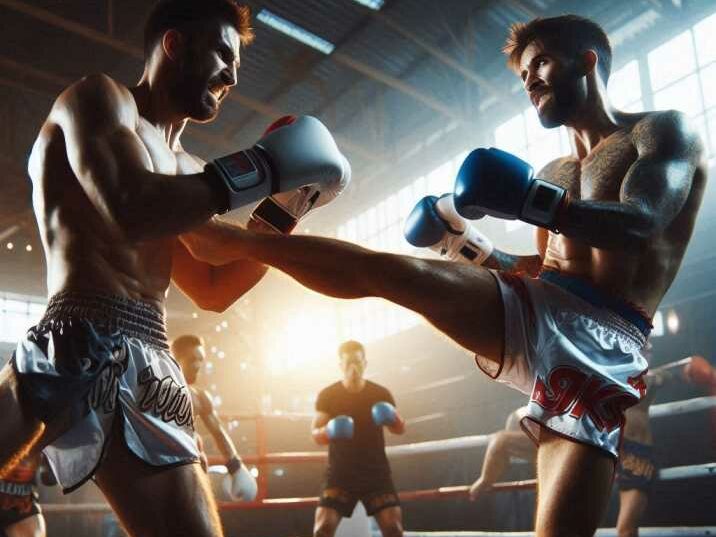Introduction
Table of Contents
In the world of martial arts, Muay Thai and Judo stand out as two distinct styles, each with its unique techniques, philosophies, and histories. Whether you’re a seasoned martial artist looking to expand your skill set or a beginner trying to decide which discipline to pursue, understanding the differences and similarities between Muay Thai vs Judo is crucial. In this comprehensive blog post, we’ll delve into the origins, techniques, training methods, benefits, and competitive aspects of both martial arts. By the end, you’ll have a clear understanding of what sets Muay Thai and Judo apart and which might be the best fit for your goals.

Muay Thai vs Judo
When it comes to combat sports, the choice between Muay Thai and Judo can be a difficult one. Both martial arts offer unique skills, training methods, and benefits. Let’s explore the distinctions between these two fighting styles to help you determine which might be the best fit for you.
Table of Contents
- The Origins and History of Muay Thai
- The Origins and History of Judo
- Techniques and Strategies in Muay Thai
- Techniques and Strategies in Judo
- Training Methods and Routines
- Physical and Mental Benefits
- Competitive Aspects: Rules and Regulations
- Which Martial Art is Right for You?
- Frequently Asked Questions (FAQs)
- Conclusion
The Origins and History of Muay Thai
Muay Thai, often referred to as “The Art of Eight Limbs,” has its roots in Thailand and dates back over a thousand years. Originally developed for military combat, it evolved into a sport and national pastime. The eight limbs refer to the use of fists, elbows, knees, and shins in combat, making it one of the most versatile and effective striking arts.
Key Historical Milestones
- Ancient Beginnings: Muay Thai originated from ancient battlefield tactics of the Thai army called “Muay Boran.”
- Kingdom of Sukhothai: During this period (1238-1583 AD), Muay Thai became a formalized combat system.
- Modern Era: In the 20th century, Muay Thai adopted Western boxing rules, including weight classes and the use of gloves.
Cultural Significance
Muay Thai is deeply ingrained in Thai culture, with traditional ceremonies and rituals still performed before matches. Fighters often participate in a ritual dance called “Wai Kru” to pay respect to their teachers and the sport itself.
The Origins and History of Judo
Judo, meaning “gentle way,” was founded by Jigoro Kano in Japan in 1882. Kano sought to create a martial art that emphasized technique over brute strength, focusing on throws, joint locks, and pins. Judo’s philosophy is rooted in the principles of maximum efficiency and mutual welfare and benefit.
Key Historical Milestones
- Founding: Jigoro Kano established the Kodokan Judo Institute in Tokyo in 1882.
- Olympic Recognition: Judo became an Olympic sport in 1964, highlighting its global appeal and competitive nature.
- Global Spread: Judo has become one of the most widely practiced martial arts worldwide, with millions of practitioners.
Cultural Significance
Judo is not only a sport but also a way of life that emphasizes respect, discipline, and continuous self-improvement. Practitioners, known as judokas, follow a strict code of conduct both on and off the mat.
Techniques and Strategies in Muay Thai
Muay Thai is renowned for its powerful strikes and clinch work. The primary techniques include punches, kicks, elbows, and knee strikes.
Striking Techniques
- Punches: Similar to Western boxing, including jabs, crosses, hooks, and uppercuts.
- Kicks: Powerful roundhouse kicks are a staple, targeting the legs, body, and head.
- Elbows: Used in close-range combat to deliver devastating strikes.
- Knees: Effective in the clinch, targeting the opponent’s midsection and head.
Defensive Techniques
- Blocks: Using arms and legs to absorb or deflect strikes.
- Parries: Redirecting an opponent’s attack with minimal contact.
- Footwork: Essential for maintaining distance and creating angles for attacks.
The Clinch
The clinch is a defining feature of Muay Thai, where fighters engage in close-range combat, controlling their opponent’s posture and delivering knee strikes and elbows.
Techniques and Strategies in Judo
Judo emphasizes throws, groundwork, and submissions rather than strikes. The primary techniques are divided into two categories: Tachi-waza (standing techniques) and Ne-waza (ground techniques).
Throwing Techniques (Tachi-waza)
- Hip Throws (Koshi-waza): Using the hip as a fulcrum to throw the opponent.
- Foot Throws (Ashi-waza): Sweeping or reaping the opponent’s legs to unbalance and throw them.
- Hand Throws (Te-waza): Using the hands and arms to execute throws.
Ground Techniques (Ne-waza)
- Pins (Osae-komi-waza): Holding the opponent on their back for a set period.
- Joint Locks (Kansetsu-waza): Applying pressure to joints to force a submission.
- Chokes (Shime-waza): Restricting blood flow or air to force a submission.
Defensive Techniques
- Breakfalls (Ukemi): Techniques to safely land after being thrown.
- Counters: Using an opponent’s momentum against them to execute a throw or submission.
Training Methods and Routines
Muay Thai Training
Muay Thai training is intense and focuses on building cardiovascular endurance, strength, and striking technique. A typical training session may include:
- Warm-Up: Jump rope, shadow boxing, and dynamic stretching.
- Bag Work: Striking heavy bags to develop power and technique.
- Pad Work: Hitting pads held by a trainer to practice combinations and improve accuracy.
- Sparring: Controlled practice fights to apply techniques in a realistic setting.
- Conditioning: Bodyweight exercises, running, and strength training.
Judo Training
Judo training emphasizes technique, timing, and physical conditioning. A typical training session, known as a “Randori,” may include:
- Warm-Up: Joint rotations, stretching, and light calisthenics.
- Uchikomi: Repetitive practice of throw entry techniques.
- Nagekomi: Full execution of throws with a partner.
- Ne-waza Drills: Practicing pins, joint locks, and chokes on the ground.
- Randori: Free practice sessions where practitioners spar to apply techniques.
- Conditioning: Strength training, cardio, and flexibility exercises.
Physical and Mental Benefits
Physical Benefits of Muay Thai
- Cardiovascular Fitness: High-intensity training improves heart health and endurance.
- Strength and Power: Striking and clinch work build muscle strength.
- Flexibility: Dynamic movements increase flexibility and mobility.
- Weight Loss: Intense workouts burn calories and aid in weight management.
Mental Benefits of Muay Thai
- Discipline: Regular training instills discipline and work ethic.
- Confidence: Learning self-defense techniques boosts self-confidence.
- Stress Relief: Physical activity releases endorphins, reducing stress and anxiety.
Physical Benefits of Judo
- Strength and Conditioning: Throwing and grappling build full-body strength.
- Balance and Coordination: Techniques require precise balance and coordination.
- Flexibility: Regular practice improves joint and muscle flexibility.
- Endurance: Continuous sparring enhances cardiovascular endurance.
Mental Benefits of Judo
- Problem-Solving: Judo encourages strategic thinking and adaptability.
- Respect and Humility: The culture of Judo promotes respect for others and humility.
- Focus: Training improves mental focus and concentration.
- Stress Relief: Physical exertion and mental engagement reduce stress levels.
Competitive Aspects: Rules and Regulations
Muay Thai Competition Rules
- Rounds: Typically consists of 3 to 5 rounds, each lasting 3 minutes.
- Scoring: Points are awarded for effective strikes, aggression, and defense.
- Legal Techniques: Punches, kicks, elbows, knees, and clinch work.
- Illegal Techniques: Headbutts, groin strikes, and attacks to the back of the head.
Judo Competition Rules
- Duration: Matches last 4 minutes for men and women.
- Scoring: Points are awarded for successful throws, pins, and submissions.
- Legal Techniques: Throws, pins, joint locks, and chokes.
- Illegal Techniques: Strikes, attacks to the spine, and certain joint locks.
Which Martial Art is Right for You?
Choosing between Muay Thai and Judo depends on your personal goals, interests, and physical capabilities. Here’s a quick guide to help you decide:
Choose Muay Thai If:
- You prefer striking and stand-up combat.
- You’re interested in high-intensity workouts.
- You want to improve your cardiovascular fitness and strength.
- You enjoy a mix of traditional and modern martial arts.
Choose Judo If:
- You prefer grappling and ground combat.
- You’re interested in technique and leverage over brute strength.
- You want to improve your balance, coordination, and flexibility.
- You appreciate a martial art with a strong philosophical foundation.
Conclusion
Muay Thai and Judo, while different in their techniques and philosophies, both offer incredible benefits for practitioners. Whether you are drawn to the striking power and intensity of Muay Thai or the strategic grappling and balance of Judo, both martial arts can contribute significantly to your physical and mental well-being. By understanding the unique aspects of each, you can make an informed decision about which path to pursue. Remember, the journey in martial arts is as rewarding as the destination, and the skills and discipline you acquire will serve you well in various aspects of life.
Frequently Asked Questions (FAQs)
1. Can I train in both Muay Thai and Judo?
Yes, many martial artists cross-train in multiple disciplines to become well-rounded fighters.
2. Which martial art is better for self-defense?
Both are effective for self-defense, but Muay Thai is more focused on striking, while Judo emphasizes throws and submissions.
3. Is Muay Thai more physically demanding than Judo?
Both are physically demanding in different ways. Muay Thai requires intense cardiovascular and striking training, while Judo demands strength, balance, and flexibility.
4. Do I need any prior experience to start training in Muay Thai or Judo?
No prior experience is necessary. Both martial arts welcome beginners and offer foundational classes to help you get started.
5. How long does it take to become proficient in Muay Thai or Judo?
Proficiency varies depending on the individual and their training frequency. Generally, it takes several years of consistent training to become proficient in either discipline.


